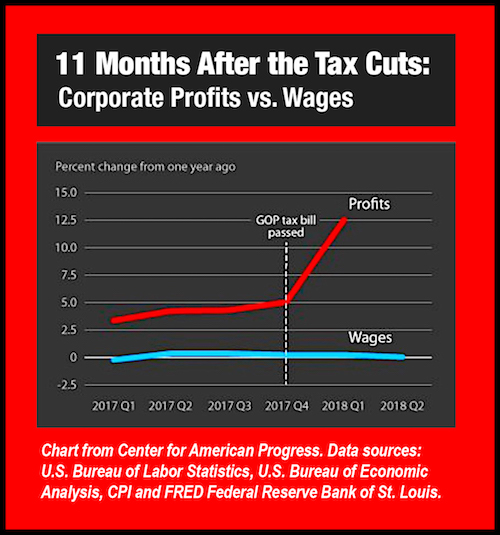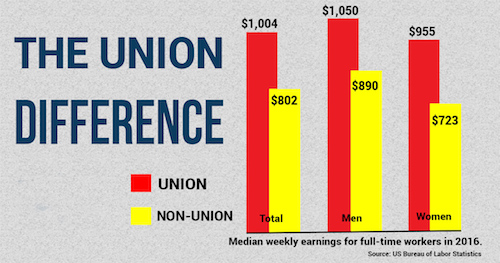Despite the lowest U.S. unemployment rate in 50 years, the American Dream is elusive for most working people, according to a new “Opportunity Index” based on data from the nation’s 204 most populous metro areas.
“It's not about how many jobs are open or how many people have jobs, but it's about how good those jobs are,” said Ryan Bhandari, co-author of the report, published by the think tank Third Way.
The results, said Jim Kessler, a Third Way executive and the report’s editor, reflect an “opportunity crisis” in the United States.
Measuring the quality and quantity of jobs in areas ranging from New York City to Kennewick, Wash., researchers found that just 38 percent of jobs pay enough for a four-person family with two working parents to enjoy a middle- or upper-income lifestyle.
The other 62 percent is divided nearly equally between living-wage jobs, defined as paying enough for a single, childless adult to sustain a modest standard of living with no frills, and hardship jobs that pay so little that even workers with no dependents can’t make ends meet.
“This reality explains why, nine years into a recovery and facing 3.7 percent unemployment, American workers still feel distressed economically,” the report concluded.
Added to the growing body of research on sluggish wages and rising inequality, the study is more evidence that the “booming” economy is leaving the majority of Americans behind.

|
| Wages are still flat overall since the GOP tax cuts, while corporate profits have climbed 7.5 percent on average, as the chart illustrates.
|
“That long-term feeling of stagnation, which has robbed many middle-class Americans of the dream of a better life for their children, has also artificially depressed the labor market,” Marketwatch, owned by Rupert Murdoch’s News Corp., reported Nov. 26. “Alongside a political war on unions, low wages have dismantled worker bargaining power and made employers greedier about how much they can squeeze out of individual workers.”
Given those obstacles, Third Way crunched federal data on wages, cost of living and local employment-to-population ratios to determine which areas offer the most, and least, economic opportunity for workers and their families.
For example, a job in Cedar Rapids, Iowa., which ranked second on the index, needs to pay just over $40,000 to provide a middle-class life, less than half what the same standard of living costs in San Francisco, which ranked 149th.
Third Way – which the New York Times has described as a “radically centrist” organization – acknowledges that the index is strictly a numbers game. It doesn’t measure things that make more expensive areas appealing to many people, doesn’t consider the desirability of jobs or analyze an area’s potential for growth. It simply calculates where workers are more or less likely to fall into the middle class.
Workers’ ability to build savings, take vacations, eat out and, more critically, afford health care were factors in determining where their communities landed on the opportunity scale, Bhandari said in an interview with the Daily Mail.
'We took all that information and created our conception of a middle-class job that we think matches up pretty well with what American people want,” he said.
Among the findings:
- Of the 38 percent of jobs that provide some opportunity for upward mobility, 23 percent are middle class, classified as paying enough to support at least half the expenses of a family of four. In dollar terms, that ranges from $44,820 to $80,426 annually, depending on the community. The other 15 percent of jobs are classified as professional, based on higher salaries, not type of work.
- Rochester, Minn., tops the opportunity scale, with 45 percent of jobs considered middle class or better. At 35 percent, Fayetteville, N.C. came in last.
- Of the 204 metropolitan statistical areas studied, 12 of the bottom 20 are in the South. Researchers attribute that to a lack of available jobs, not cost of living.
- In seemingly thriving coastal areas, however, cost of living is the paramount factor driving down opportunity. New York City ranks 135, Los Angeles ranks 143 and affluent Salinas, Calif., is third from last at 202.
The Marketwatch report noted that workers have seen income gains since the 1970s of only 11 percent, while CEO pay has skyrocketed by 1,000 percent.
Executive pay continues to soar a year after the GOP tax cuts, while workers struggle to keep up with inflation. Corporations that promised to invest tax savings in higher wages and new jobs are collectively hoarding billions of dollars and sending the fattest checks ever to shareholders, the vast majority of whom are already part of the 1 percent.

|
| Unions built America’s middle class and are still, despite decades of attacks, workers’ surest path to economic security.
|
General Motors, which is saving $157 million in taxes this year alone, left workers reeling with last week’s news that it would shut down five plants and cut 14,000 jobs. What was a body blow to workers and the affected GM communities in Michigan, Detroit, Ohio and Ontario, Canada, was a heyday for investors: share prices soared nearly 8 percent immediately after the announcement.
It wasn’t always that way, Washington Post columnist Christopher Ingraham wrote the next day, explaining that corporate profits and labor income were largely in tandem for most of the last half of the 20th century.
“But starting in 2003, profits take off, leaving wages in the dust. The Great Recession took a bite out of corporate profits, but since about 2009, profits have been on an unstoppable tear while labor income has plodded along much more slowly.”
Turning that around will require political courage to support strong unions and other workers’ rights, while holding corporations to account, International President Lonnie R. Stephenson said.
“As IBEW members, we’re among the lucky ones – workers with good contracts that provide a level of pay and benefits that more Americans used to enjoy,” he said. “Now, many of our friends and neighbors fall on the grim end of the Opportunity Index, and it’s going to get worse without real change.
“That means keeping the pressure on politicians we helped elect in November, making sure they keep their promises, and committing ourselves to strengthen the gains we made with every election.”